DUE QUI/TO HEAR: ITALY’S PAVILION FOR THE VENICE BIENNALE
Due qui / To Hear is the project for the Italian Pavilion at the 60th Venice Biennale Curated by Luca Cerizza (with the assistance of Francesca Verga), it presents work that Massimo Bartolini has created in collaboration with several musicians (for the permanent installations) and writers (for the public program), employing the cooperative approach that is a hallmark of his practice.
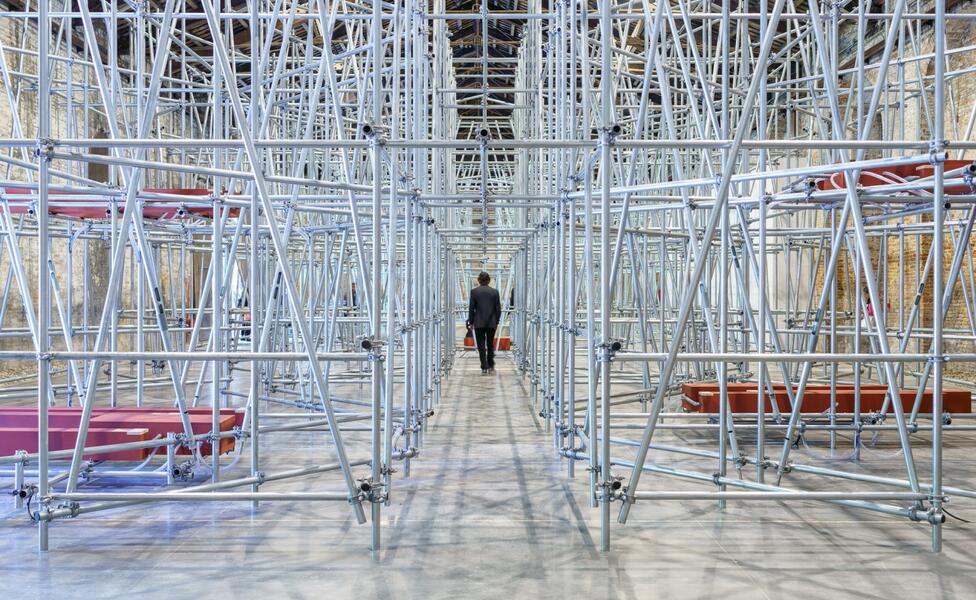
Playing on the homophones “two here” (in Italian, due qui) and “to hear,” in a translation that is only wrong at first glance, the title suggests that hearing—or rather, listening, the act of straining one’s ears—is an action directed towards others. Meeting and listening, relation and sound, go hand in hand in this project, as they have throughout the three decades of Massimo Bartolini’s practice.
The acoustic paradigm should be thought of here as a physical experience, but also as a metaphor, an invitation to pay attention: to listen to the Other, be it a human being, a machinic element, or a natural form. In Bartolini’s view, art is a path to knowledge, and the project suggests that “lending an ear” could become a tool for self-improvement within the community of this world.
-
Pavilion of ITALY. DUE QUI / TO HEAR. 60th International Art Exhibition - La Biennale di Venezia. Andrea Avezzù . Courtesy: La Biennale di Venezia
-
Pavilion of ITALY. DUE QUI / TO HEAR. 60th International Art Exhibition - La Biennale di Venezia. Andrea Avezzù . Courtesy: La Biennale di Venezia
-
Pavilion of ITALY. DUE QUI / TO HEAR. 60th International Art Exhibition - La Biennale di Venezia. Andrea Avezzù . Courtesy: La Biennale di Venezia
-
Pavilion of ITALY. DUE QUI / TO HEAR. 60th International Art Exhibition - La Biennale di Venezia. Andrea Avezzù . Courtesy: La Biennale di Venezia
-
Pavilion of ITALY. DUE QUI / TO HEAR. 60th International Art Exhibition - La Biennale di Venezia. Andrea Avezzù . Courtesy: La Biennale di Venezia
-
Pavilion of ITALY. DUE QUI / TO HEAR. 60th International Art Exhibition - La Biennale di Venezia. Andrea Avezzù . Courtesy: La Biennale di Venezia
-
Pavilion of ITALY. DUE QUI / TO HEAR. 60th International Art Exhibition - La Biennale di Venezia. Andrea Avezzù . Courtesy: La Biennale di Venezia
Through sculptures, installations, sound works, and performances, with a range that is characteristic of this artist, the project endeavors to create a context of experience. Visitors to the pavilion move along a path that can be followed in either direction, through three areas built around acoustic experiences and meeting points that respond to the physical characteristics of each exhibition space, without adopting any form of display. Within this context, we encounter sound works created with the aid of musicians from different generations. Caterina Barbieri (b. 1990, Italy) and Kali Malone (b. 1994, United States), two leading figures in the field of electronic and experimental music, have jointly composed a piece for Bartolini’s primary installation, which occupies the entire main room of the exhibition space as an environment that visitors can walk through. Together with his son Yuri (b. 1990, Canada), the re-known minimalist and experimental musician Gavin Bryars (b. 1943, United Kingdom) has written a choral composition based on a poem by Argentinian writer Robert Juarroz. A veces ya no puedo moverme (“Sometimes I can no longer move”) alludes to a human being who feels like a tree, or some other form of plant life connected to the world by its roots, “as if everything were born in me or as if I were born in everything.”
The same collaborative approach found in the permanent works is also present in the more performative and discursive side of the project. Children’s book author and illustrator Nicoletta Costa and novelist and poet Tiziano Scarpa have written new short stories that was performed in the garden during the opening days of the Biennale, while an extensive Public Program, curated by Luca Cerizza in collaboration with Gaia Martino, will accompany the exhibition. Inspired by a quote from musician, artist, and theorist John Cage, If Only We Had Ears will alternate talks, interviews, musical performances, conversations, and workshops from mid-May to mid-September. The events, presented in the Giardino delle Vergini, are organized around four angles of the acoustic paradigm, to lend a voice to the human, social, spiritual, and ecological perspective suggested by the project in the Italian Pavilion. Guests include: Elena Biserna, Nina Eidsheim, Haytham El-Wardany, Attila Faravelli, Michelangelo Frammartino, George David Haskell, Neelaksh Josh, Brandon LaBelle, Valentina Megaletti, Maurizio Maggiani, Enrico Malatesta, Pedro Oliveira, Diana Lola Posani, Nicola Ratti, Veniero Rizzardi, Francesca Tarocco, Marco Vannini, and David Toop.
May interest you
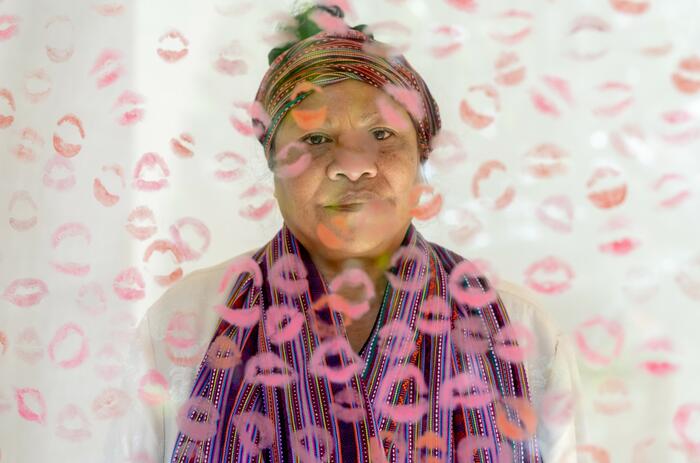
Maria Madeira is the artist representing Timor-Leste at the 60th International Venice Biennale. Timor-Leste’s inaugural pavilion coincides with the country’s 25th anniversary of independence. Commissioned by the Ministry of Youth, Sports, Arts and Culture, Democratic Republic of Timor-Leste and curated by Professor Natalie King OAM.
KISS AND DON’T TELL: TIMOR-LESTE IN THE VENICE BIENNALE
Maria Madeira is the artist representing Timor-Leste at the 60th International Venice Biennale. Timor-Leste’s inaugural pavilion coincides with the country’s 25th anniversary of independence. Commissioned by the Ministry of Youth, Sports, Arts and Culture, Democratic Republic of Timor-Leste and curated by Professor Natalie King OAM.

Maria Madeira is the artist representing Timor-Leste at the 60th International Venice Biennale. Timor-Leste’s inaugural pavilion coincides with the country’s 25th anniversary of independence. Commissioned by the Ministry of Youth, Sports, Arts and Culture, Democratic Republic of Timor-Leste and curated by Professor Natalie King OAM.
KISS AND DON’T TELL: TIMOR-LESTE IN THE VENICE BIENNALE
Maria Madeira is the artist representing Timor-Leste at the 60th International Venice Biennale. Timor-Leste’s inaugural pavilion coincides with the country’s 25th anniversary of independence. Commissioned by the Ministry of Youth, Sports, Arts and Culture, Democratic Republic of Timor-Leste and curated by Professor Natalie King OAM.
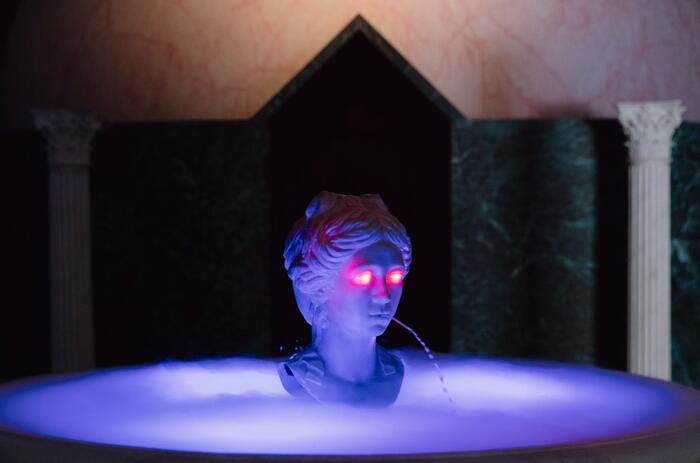
The Venice Bienanale’s Swiss Pavilion presents Super Superior Civilizations: an exhibition with the sixth and seventh chapters of Guerreiro do Divino Amor’s monumental “Superfictional World Atlas” saga: The Miracle of Helvetia and Roma Talismano. Curated by: Andrea Bellini.
THE SWISS PAVILION’S VENICE BIENNALE EXHIBITION BY GUERREIRO DO DIVINO AMOR
The Venice Bienanale’s Swiss Pavilion presents Super Superior Civilizations: an exhibition with the sixth and seventh chapters of Guerreiro do Divino Amor’s monumental “Superfictional World Atlas” saga: The Miracle of Helvetia and Roma Talismano. Curated by: Andrea Bellini.

For the 60th Venice Biennale, the Republic of Armenia presents Echo, a multi-dimensional multi-media installation project by Paris-based Armenian artist Nina Khemchyan.
“ECHO” BY NINCA KHEMCHYAN: ARMENIAN PAVILION IN THE VENICE BIENNALE
For the 60th Venice Biennale, the Republic of Armenia presents Echo, a multi-dimensional multi-media installation project by Paris-based Armenian artist Nina Khemchyan.
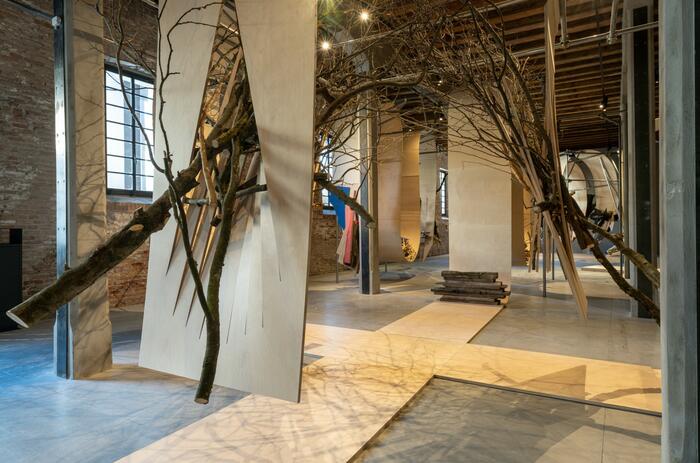
Ojalá se derrumben las puertas (Hopefully the Doors Will Fall Down) by artist Luciana Lamothe, curated by Sofía Dourron, is the installation presented by the Argentine Pavilion at the 60th International Art Exhibition of the Venice Biennale 2024.
THE ARGENTINE PAVILION IN THE VENICE BIENNALE
Ojalá se derrumben las puertas (Hopefully the Doors Will Fall Down) by artist Luciana Lamothe, curated by Sofía Dourron, is the installation presented by the Argentine Pavilion at the 60th International Art Exhibition of the Venice Biennale 2024.

The heart of a giraffe in captivity is twelve kilos lighter tells the story of Lenka the giraffe, drawing on the history of Czechoslovakia’s acquisition of animals from the Global South. Interpreted through contemporary ecological and decolonial perspectives, Eva Kotátková’s project of the Czech and Slovak Republic Pavilion at the Venice Biennale builds a space for imagining a different way of relating to nature.
THE VENICE BIENNALE: CZECH AND SLOVAK REPUBLIC PAVILION
The heart of a giraffe in captivity is twelve kilos lighter tells the story of Lenka the giraffe, drawing on the history of Czechoslovakia’s acquisition of animals from the Global South. Interpreted through contemporary ecological and decolonial perspectives, Eva Kotátková’s project of the Czech and Slovak Republic Pavilion at the Venice Biennale builds a space for imagining a different way of relating to nature.
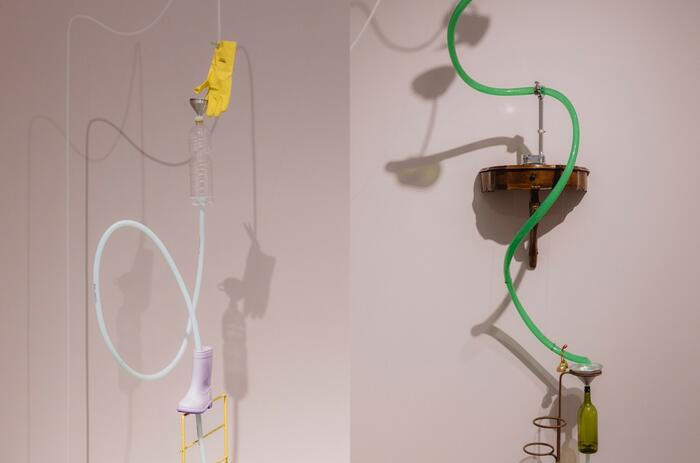
The Japan Foundation, the commissioner of the Japan Pavilion presents Compose, a solo exhibition created by Yuko Mohri and curated by Sook-Kyung Lee at the 60th International Venice Biennale.
COMPOSE: JAPAN PAVILION AT THE VENICE BIENNALE
The Japan Foundation, the commissioner of the Japan Pavilion presents Compose, a solo exhibition created by Yuko Mohri and curated by Sook-Kyung Lee at the 60th International Venice Biennale.

Commissioned by Facundo de Almeida and curated by Elisa Valerio, the national pavilion of Uruguay presents the work of Eduardo Cardozo with the project Latent.
THE PAVILION OF URUGUAY AT THE 60TH VENICE BIENNALE
Commissioned by Facundo de Almeida and curated by Elisa Valerio, the national pavilion of Uruguay presents the work of Eduardo Cardozo with the project Latent.
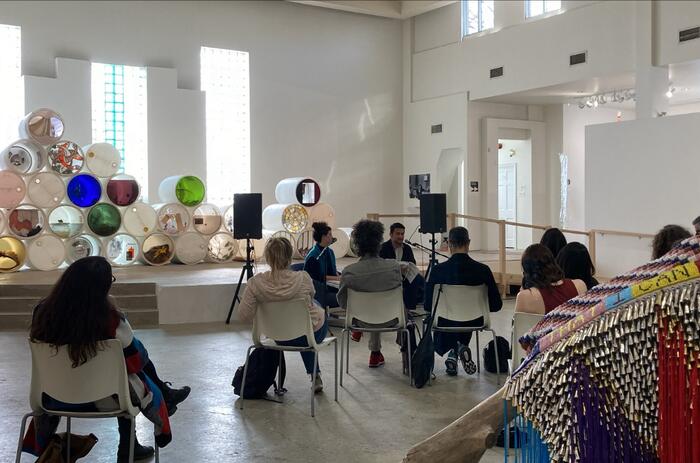
The curatorial team of the Toronto Biennial of Art (the Biennial/TBA) and its curatorial team of Dominique Fontaine and Miguel A. López announced the title, full artist list and venues for its third edition.
TORONTO BIENNIAL OF ART: PRECARIOUS JOYS
The curatorial team of the Toronto Biennial of Art (the Biennial/TBA) and its curatorial team of Dominique Fontaine and Miguel A. López announced the title, full artist list and venues for its third edition.
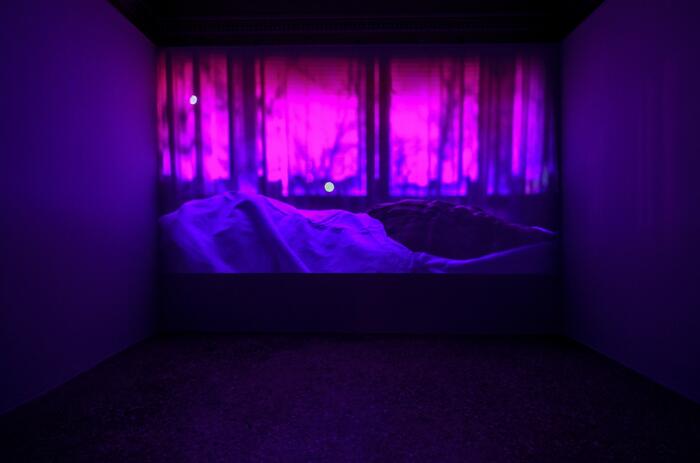
The Georgian Pavilion in the 60th Venice Biennale presented The Art of Seeing– States of Astronomy, a collaborative project presented by a team of Georgian and French curators and artists.
THE ART OF SEEING: GEORGIA’S PAVILION IN THE VENICE BIENNALE
The Georgian Pavilion in the 60th Venice Biennale presented The Art of Seeing– States of Astronomy, a collaborative project presented by a team of Georgian and French curators and artists.
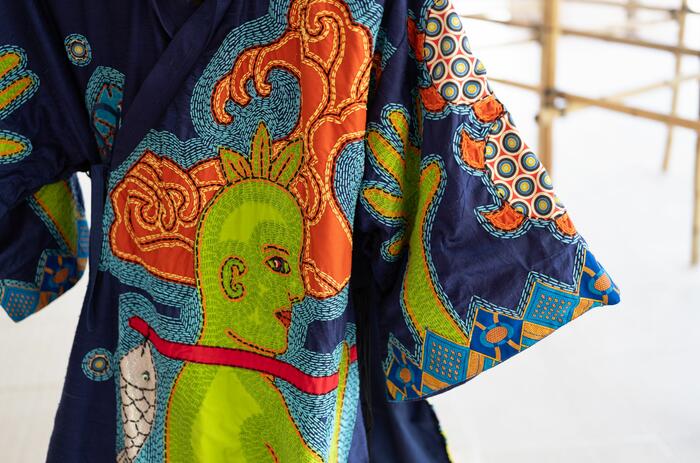
For the 60th International Art Exhibition – La Biennale di Venezia, the Nordic Countries Pavilion invites the audience to embark on a journey aboard a spectral dragon ship which occupies the light and open architecture of Sverre Fehn’s meditative masterpiece in the Giardini of the Biennale, Venice.
THE ALTERSEA OPERA: THE NORDIC COUNTRIES PAVILION'S PROPOSAL
For the 60th International Art Exhibition – La Biennale di Venezia, the Nordic Countries Pavilion invites the audience to embark on a journey aboard a spectral dragon ship which occupies the light and open architecture of Sverre Fehn’s meditative masterpiece in the Giardini of the Biennale, Venice.

The International Celebration of Blasphemy and The Sacred is a presentation by Congolese artist collective Cercle d’Art des Travailleurs de Plantation Congolaise (CATPC) for the Dutch Pavilion at the 60th Venice Biennale.
DUTCH PAVILION AT THE VENICE BIENNALE
The International Celebration of Blasphemy and The Sacred is a presentation by Congolese artist collective Cercle d’Art des Travailleurs de Plantation Congolaise (CATPC) for the Dutch Pavilion at the 60th Venice Biennale.
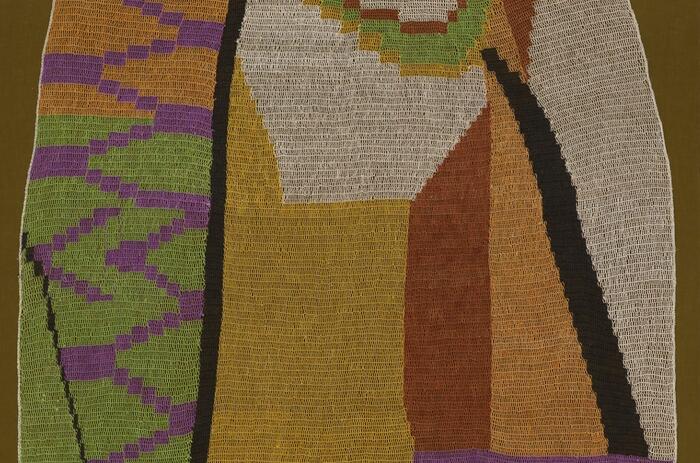
For the 60th International Exhibition of la Biennale di Venezia Stranieri Ovunque (Foregneirs Everywhere), artist Claudia Alarcón and art-collective Silät are presenting their reflections on being treated as foreigners in their own country.
CLAUDIA ALARCÓN AND SILÄT’S VENICE BIENNALE PARTICIPATION
For the 60th International Exhibition of la Biennale di Venezia Stranieri Ovunque (Foregneirs Everywhere), artist Claudia Alarcón and art-collective Silät are presenting their reflections on being treated as foreigners in their own country.
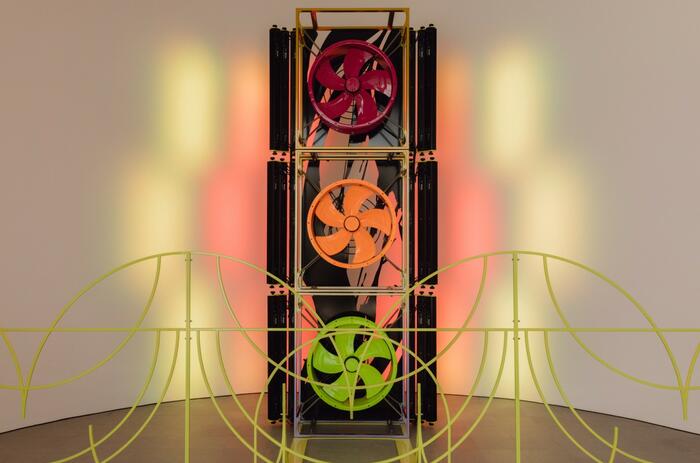
For the 60th International Venice Biennale, Nemes designed the project as an immersive, painting-based Gesamtkunstwerk that expands the genre of painting and extends it to other media. Project curated by Róna Kopeczky.
TECHNO ZEN BY MÁRTON NEMEZ: THE HUNGARIAN PAVILION IN VENICE BIENNALE
For the 60th International Venice Biennale, Nemes designed the project as an immersive, painting-based Gesamtkunstwerk that expands the genre of painting and extends it to other media. Project curated by Róna Kopeczky.
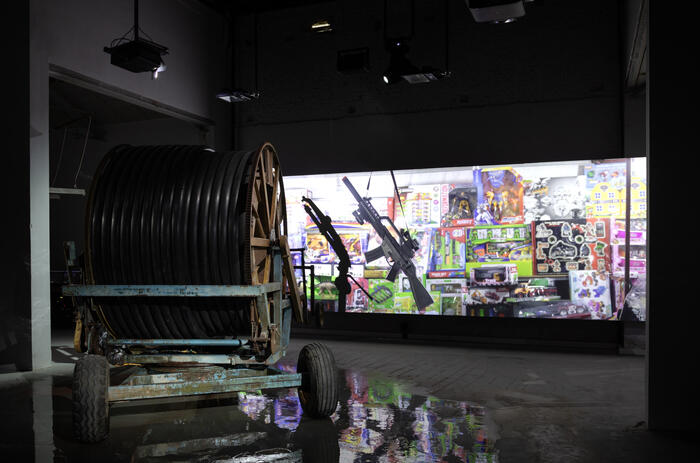
Xirómero / Dryland is an interdisciplinary collective work conceived by Thanasis Deligiannis and Yannis Michalopoulos, created along with the artists Elia Kalogianni, Yorgos Kyvernitis, Kostas Chaikalis and Fotis Sagonas for the Greek Pavilion at the 60th Venice Biennale. The project is curated by Panos Giannikopoulos.
WATER AS A PRISM: GREEK PAVILION AT THE VENICE BIENNALE
Xirómero / Dryland is an interdisciplinary collective work conceived by Thanasis Deligiannis and Yannis Michalopoulos, created along with the artists Elia Kalogianni, Yorgos Kyvernitis, Kostas Chaikalis and Fotis Sagonas for the Greek Pavilion at the 60th Venice Biennale. The project is curated by Panos Giannikopoulos.

The exhibition of the 60th edition of the Venice Biennale - Stranieri Ovunque (Foregneirs Everywhere) - curated by Brazilian Adriano Pedrosa, presents 331 artists, significantly more than the usual number. More than a third of those artists come from Latin America.
FOREIGNERS EVERYWHERE: LATIN AMERICA TAKES OVER THE VENICE BIENNALE
The exhibition of the 60th edition of the Venice Biennale - Stranieri Ovunque (Foregneirs Everywhere) - curated by Brazilian Adriano Pedrosa, presents 331 artists, significantly more than the usual number. More than a third of those artists come from Latin America.
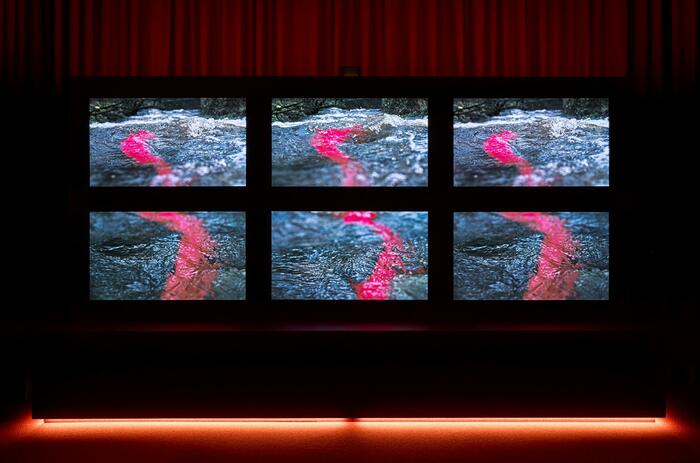
The monumental commission by British artist John Akomfrah RA for the 2024 Venice Biennale is a multi-layered exhibition which encourages visitors to experience the British Pavilion’s 19th century neoclassical building in a new way.
THE SOUNDS OF TIME – UNITED KINGDOM AT THE VENICE BIENNALE
The monumental commission by British artist John Akomfrah RA for the 2024 Venice Biennale is a multi-layered exhibition which encourages visitors to experience the British Pavilion’s 19th century neoclassical building in a new way.

Maria Madeira is the artist representing Timor-Leste at the 60th International Venice Biennale. Timor-Leste’s inaugural pavilion coincides with the country’s 25th anniversary of independence. Commissioned by the Ministry of Youth, Sports, Arts and Culture, Democratic Republic of Timor-Leste and curated by Professor Natalie King OAM.
KISS AND DON’T TELL: TIMOR-LESTE IN THE VENICE BIENNALE
Maria Madeira is the artist representing Timor-Leste at the 60th International Venice Biennale. Timor-Leste’s inaugural pavilion coincides with the country’s 25th anniversary of independence. Commissioned by the Ministry of Youth, Sports, Arts and Culture, Democratic Republic of Timor-Leste and curated by Professor Natalie King OAM.

The Venice Bienanale’s Swiss Pavilion presents Super Superior Civilizations: an exhibition with the sixth and seventh chapters of Guerreiro do Divino Amor’s monumental “Superfictional World Atlas” saga: The Miracle of Helvetia and Roma Talismano. Curated by: Andrea Bellini.
THE SWISS PAVILION’S VENICE BIENNALE EXHIBITION BY GUERREIRO DO DIVINO AMOR
The Venice Bienanale’s Swiss Pavilion presents Super Superior Civilizations: an exhibition with the sixth and seventh chapters of Guerreiro do Divino Amor’s monumental “Superfictional World Atlas” saga: The Miracle of Helvetia and Roma Talismano. Curated by: Andrea Bellini.

For the 60th Venice Biennale, the Republic of Armenia presents Echo, a multi-dimensional multi-media installation project by Paris-based Armenian artist Nina Khemchyan.
“ECHO” BY NINCA KHEMCHYAN: ARMENIAN PAVILION IN THE VENICE BIENNALE
For the 60th Venice Biennale, the Republic of Armenia presents Echo, a multi-dimensional multi-media installation project by Paris-based Armenian artist Nina Khemchyan.

Ojalá se derrumben las puertas (Hopefully the Doors Will Fall Down) by artist Luciana Lamothe, curated by Sofía Dourron, is the installation presented by the Argentine Pavilion at the 60th International Art Exhibition of the Venice Biennale 2024.
THE ARGENTINE PAVILION IN THE VENICE BIENNALE
Ojalá se derrumben las puertas (Hopefully the Doors Will Fall Down) by artist Luciana Lamothe, curated by Sofía Dourron, is the installation presented by the Argentine Pavilion at the 60th International Art Exhibition of the Venice Biennale 2024.

The heart of a giraffe in captivity is twelve kilos lighter tells the story of Lenka the giraffe, drawing on the history of Czechoslovakia’s acquisition of animals from the Global South. Interpreted through contemporary ecological and decolonial perspectives, Eva Kotátková’s project of the Czech and Slovak Republic Pavilion at the Venice Biennale builds a space for imagining a different way of relating to nature.
THE VENICE BIENNALE: CZECH AND SLOVAK REPUBLIC PAVILION
The heart of a giraffe in captivity is twelve kilos lighter tells the story of Lenka the giraffe, drawing on the history of Czechoslovakia’s acquisition of animals from the Global South. Interpreted through contemporary ecological and decolonial perspectives, Eva Kotátková’s project of the Czech and Slovak Republic Pavilion at the Venice Biennale builds a space for imagining a different way of relating to nature.

The Japan Foundation, the commissioner of the Japan Pavilion presents Compose, a solo exhibition created by Yuko Mohri and curated by Sook-Kyung Lee at the 60th International Venice Biennale.
COMPOSE: JAPAN PAVILION AT THE VENICE BIENNALE
The Japan Foundation, the commissioner of the Japan Pavilion presents Compose, a solo exhibition created by Yuko Mohri and curated by Sook-Kyung Lee at the 60th International Venice Biennale.

Commissioned by Facundo de Almeida and curated by Elisa Valerio, the national pavilion of Uruguay presents the work of Eduardo Cardozo with the project Latent.
THE PAVILION OF URUGUAY AT THE 60TH VENICE BIENNALE
Commissioned by Facundo de Almeida and curated by Elisa Valerio, the national pavilion of Uruguay presents the work of Eduardo Cardozo with the project Latent.

The curatorial team of the Toronto Biennial of Art (the Biennial/TBA) and its curatorial team of Dominique Fontaine and Miguel A. López announced the title, full artist list and venues for its third edition.
TORONTO BIENNIAL OF ART: PRECARIOUS JOYS
The curatorial team of the Toronto Biennial of Art (the Biennial/TBA) and its curatorial team of Dominique Fontaine and Miguel A. López announced the title, full artist list and venues for its third edition.

The Georgian Pavilion in the 60th Venice Biennale presented The Art of Seeing– States of Astronomy, a collaborative project presented by a team of Georgian and French curators and artists.
THE ART OF SEEING: GEORGIA’S PAVILION IN THE VENICE BIENNALE
The Georgian Pavilion in the 60th Venice Biennale presented The Art of Seeing– States of Astronomy, a collaborative project presented by a team of Georgian and French curators and artists.

For the 60th International Art Exhibition – La Biennale di Venezia, the Nordic Countries Pavilion invites the audience to embark on a journey aboard a spectral dragon ship which occupies the light and open architecture of Sverre Fehn’s meditative masterpiece in the Giardini of the Biennale, Venice.
THE ALTERSEA OPERA: THE NORDIC COUNTRIES PAVILION'S PROPOSAL
For the 60th International Art Exhibition – La Biennale di Venezia, the Nordic Countries Pavilion invites the audience to embark on a journey aboard a spectral dragon ship which occupies the light and open architecture of Sverre Fehn’s meditative masterpiece in the Giardini of the Biennale, Venice.

The International Celebration of Blasphemy and The Sacred is a presentation by Congolese artist collective Cercle d’Art des Travailleurs de Plantation Congolaise (CATPC) for the Dutch Pavilion at the 60th Venice Biennale.
DUTCH PAVILION AT THE VENICE BIENNALE
The International Celebration of Blasphemy and The Sacred is a presentation by Congolese artist collective Cercle d’Art des Travailleurs de Plantation Congolaise (CATPC) for the Dutch Pavilion at the 60th Venice Biennale.

For the 60th International Exhibition of la Biennale di Venezia Stranieri Ovunque (Foregneirs Everywhere), artist Claudia Alarcón and art-collective Silät are presenting their reflections on being treated as foreigners in their own country.
CLAUDIA ALARCÓN AND SILÄT’S VENICE BIENNALE PARTICIPATION
For the 60th International Exhibition of la Biennale di Venezia Stranieri Ovunque (Foregneirs Everywhere), artist Claudia Alarcón and art-collective Silät are presenting their reflections on being treated as foreigners in their own country.

For the 60th International Venice Biennale, Nemes designed the project as an immersive, painting-based Gesamtkunstwerk that expands the genre of painting and extends it to other media. Project curated by Róna Kopeczky.
TECHNO ZEN BY MÁRTON NEMEZ: THE HUNGARIAN PAVILION IN VENICE BIENNALE
For the 60th International Venice Biennale, Nemes designed the project as an immersive, painting-based Gesamtkunstwerk that expands the genre of painting and extends it to other media. Project curated by Róna Kopeczky.

Xirómero / Dryland is an interdisciplinary collective work conceived by Thanasis Deligiannis and Yannis Michalopoulos, created along with the artists Elia Kalogianni, Yorgos Kyvernitis, Kostas Chaikalis and Fotis Sagonas for the Greek Pavilion at the 60th Venice Biennale. The project is curated by Panos Giannikopoulos.
WATER AS A PRISM: GREEK PAVILION AT THE VENICE BIENNALE
Xirómero / Dryland is an interdisciplinary collective work conceived by Thanasis Deligiannis and Yannis Michalopoulos, created along with the artists Elia Kalogianni, Yorgos Kyvernitis, Kostas Chaikalis and Fotis Sagonas for the Greek Pavilion at the 60th Venice Biennale. The project is curated by Panos Giannikopoulos.

The exhibition of the 60th edition of the Venice Biennale - Stranieri Ovunque (Foregneirs Everywhere) - curated by Brazilian Adriano Pedrosa, presents 331 artists, significantly more than the usual number. More than a third of those artists come from Latin America.
FOREIGNERS EVERYWHERE: LATIN AMERICA TAKES OVER THE VENICE BIENNALE
The exhibition of the 60th edition of the Venice Biennale - Stranieri Ovunque (Foregneirs Everywhere) - curated by Brazilian Adriano Pedrosa, presents 331 artists, significantly more than the usual number. More than a third of those artists come from Latin America.

The monumental commission by British artist John Akomfrah RA for the 2024 Venice Biennale is a multi-layered exhibition which encourages visitors to experience the British Pavilion’s 19th century neoclassical building in a new way.
THE SOUNDS OF TIME – UNITED KINGDOM AT THE VENICE BIENNALE
The monumental commission by British artist John Akomfrah RA for the 2024 Venice Biennale is a multi-layered exhibition which encourages visitors to experience the British Pavilion’s 19th century neoclassical building in a new way.

Maria Madeira is the artist representing Timor-Leste at the 60th International Venice Biennale. Timor-Leste’s inaugural pavilion coincides with the country’s 25th anniversary of independence. Commissioned by the Ministry of Youth, Sports, Arts and Culture, Democratic Republic of Timor-Leste and curated by Professor Natalie King OAM.
KISS AND DON’T TELL: TIMOR-LESTE IN THE VENICE BIENNALE
Maria Madeira is the artist representing Timor-Leste at the 60th International Venice Biennale. Timor-Leste’s inaugural pavilion coincides with the country’s 25th anniversary of independence. Commissioned by the Ministry of Youth, Sports, Arts and Culture, Democratic Republic of Timor-Leste and curated by Professor Natalie King OAM.

The Venice Bienanale’s Swiss Pavilion presents Super Superior Civilizations: an exhibition with the sixth and seventh chapters of Guerreiro do Divino Amor’s monumental “Superfictional World Atlas” saga: The Miracle of Helvetia and Roma Talismano. Curated by: Andrea Bellini.
THE SWISS PAVILION’S VENICE BIENNALE EXHIBITION BY GUERREIRO DO DIVINO AMOR
The Venice Bienanale’s Swiss Pavilion presents Super Superior Civilizations: an exhibition with the sixth and seventh chapters of Guerreiro do Divino Amor’s monumental “Superfictional World Atlas” saga: The Miracle of Helvetia and Roma Talismano. Curated by: Andrea Bellini.

For the 60th Venice Biennale, the Republic of Armenia presents Echo, a multi-dimensional multi-media installation project by Paris-based Armenian artist Nina Khemchyan.
“ECHO” BY NINCA KHEMCHYAN: ARMENIAN PAVILION IN THE VENICE BIENNALE
For the 60th Venice Biennale, the Republic of Armenia presents Echo, a multi-dimensional multi-media installation project by Paris-based Armenian artist Nina Khemchyan.

Ojalá se derrumben las puertas (Hopefully the Doors Will Fall Down) by artist Luciana Lamothe, curated by Sofía Dourron, is the installation presented by the Argentine Pavilion at the 60th International Art Exhibition of the Venice Biennale 2024.
THE ARGENTINE PAVILION IN THE VENICE BIENNALE
Ojalá se derrumben las puertas (Hopefully the Doors Will Fall Down) by artist Luciana Lamothe, curated by Sofía Dourron, is the installation presented by the Argentine Pavilion at the 60th International Art Exhibition of the Venice Biennale 2024.

The heart of a giraffe in captivity is twelve kilos lighter tells the story of Lenka the giraffe, drawing on the history of Czechoslovakia’s acquisition of animals from the Global South. Interpreted through contemporary ecological and decolonial perspectives, Eva Kotátková’s project of the Czech and Slovak Republic Pavilion at the Venice Biennale builds a space for imagining a different way of relating to nature.
THE VENICE BIENNALE: CZECH AND SLOVAK REPUBLIC PAVILION
The heart of a giraffe in captivity is twelve kilos lighter tells the story of Lenka the giraffe, drawing on the history of Czechoslovakia’s acquisition of animals from the Global South. Interpreted through contemporary ecological and decolonial perspectives, Eva Kotátková’s project of the Czech and Slovak Republic Pavilion at the Venice Biennale builds a space for imagining a different way of relating to nature.

The Japan Foundation, the commissioner of the Japan Pavilion presents Compose, a solo exhibition created by Yuko Mohri and curated by Sook-Kyung Lee at the 60th International Venice Biennale.
COMPOSE: JAPAN PAVILION AT THE VENICE BIENNALE
The Japan Foundation, the commissioner of the Japan Pavilion presents Compose, a solo exhibition created by Yuko Mohri and curated by Sook-Kyung Lee at the 60th International Venice Biennale.

Commissioned by Facundo de Almeida and curated by Elisa Valerio, the national pavilion of Uruguay presents the work of Eduardo Cardozo with the project Latent.
THE PAVILION OF URUGUAY AT THE 60TH VENICE BIENNALE
Commissioned by Facundo de Almeida and curated by Elisa Valerio, the national pavilion of Uruguay presents the work of Eduardo Cardozo with the project Latent.

The curatorial team of the Toronto Biennial of Art (the Biennial/TBA) and its curatorial team of Dominique Fontaine and Miguel A. López announced the title, full artist list and venues for its third edition.
TORONTO BIENNIAL OF ART: PRECARIOUS JOYS
The curatorial team of the Toronto Biennial of Art (the Biennial/TBA) and its curatorial team of Dominique Fontaine and Miguel A. López announced the title, full artist list and venues for its third edition.

The Georgian Pavilion in the 60th Venice Biennale presented The Art of Seeing– States of Astronomy, a collaborative project presented by a team of Georgian and French curators and artists.
THE ART OF SEEING: GEORGIA’S PAVILION IN THE VENICE BIENNALE
The Georgian Pavilion in the 60th Venice Biennale presented The Art of Seeing– States of Astronomy, a collaborative project presented by a team of Georgian and French curators and artists.

For the 60th International Art Exhibition – La Biennale di Venezia, the Nordic Countries Pavilion invites the audience to embark on a journey aboard a spectral dragon ship which occupies the light and open architecture of Sverre Fehn’s meditative masterpiece in the Giardini of the Biennale, Venice.
THE ALTERSEA OPERA: THE NORDIC COUNTRIES PAVILION'S PROPOSAL
For the 60th International Art Exhibition – La Biennale di Venezia, the Nordic Countries Pavilion invites the audience to embark on a journey aboard a spectral dragon ship which occupies the light and open architecture of Sverre Fehn’s meditative masterpiece in the Giardini of the Biennale, Venice.

The International Celebration of Blasphemy and The Sacred is a presentation by Congolese artist collective Cercle d’Art des Travailleurs de Plantation Congolaise (CATPC) for the Dutch Pavilion at the 60th Venice Biennale.
DUTCH PAVILION AT THE VENICE BIENNALE
The International Celebration of Blasphemy and The Sacred is a presentation by Congolese artist collective Cercle d’Art des Travailleurs de Plantation Congolaise (CATPC) for the Dutch Pavilion at the 60th Venice Biennale.

For the 60th International Exhibition of la Biennale di Venezia Stranieri Ovunque (Foregneirs Everywhere), artist Claudia Alarcón and art-collective Silät are presenting their reflections on being treated as foreigners in their own country.
CLAUDIA ALARCÓN AND SILÄT’S VENICE BIENNALE PARTICIPATION
For the 60th International Exhibition of la Biennale di Venezia Stranieri Ovunque (Foregneirs Everywhere), artist Claudia Alarcón and art-collective Silät are presenting their reflections on being treated as foreigners in their own country.

For the 60th International Venice Biennale, Nemes designed the project as an immersive, painting-based Gesamtkunstwerk that expands the genre of painting and extends it to other media. Project curated by Róna Kopeczky.
TECHNO ZEN BY MÁRTON NEMEZ: THE HUNGARIAN PAVILION IN VENICE BIENNALE
For the 60th International Venice Biennale, Nemes designed the project as an immersive, painting-based Gesamtkunstwerk that expands the genre of painting and extends it to other media. Project curated by Róna Kopeczky.

Xirómero / Dryland is an interdisciplinary collective work conceived by Thanasis Deligiannis and Yannis Michalopoulos, created along with the artists Elia Kalogianni, Yorgos Kyvernitis, Kostas Chaikalis and Fotis Sagonas for the Greek Pavilion at the 60th Venice Biennale. The project is curated by Panos Giannikopoulos.
WATER AS A PRISM: GREEK PAVILION AT THE VENICE BIENNALE
Xirómero / Dryland is an interdisciplinary collective work conceived by Thanasis Deligiannis and Yannis Michalopoulos, created along with the artists Elia Kalogianni, Yorgos Kyvernitis, Kostas Chaikalis and Fotis Sagonas for the Greek Pavilion at the 60th Venice Biennale. The project is curated by Panos Giannikopoulos.

The exhibition of the 60th edition of the Venice Biennale - Stranieri Ovunque (Foregneirs Everywhere) - curated by Brazilian Adriano Pedrosa, presents 331 artists, significantly more than the usual number. More than a third of those artists come from Latin America.
FOREIGNERS EVERYWHERE: LATIN AMERICA TAKES OVER THE VENICE BIENNALE
The exhibition of the 60th edition of the Venice Biennale - Stranieri Ovunque (Foregneirs Everywhere) - curated by Brazilian Adriano Pedrosa, presents 331 artists, significantly more than the usual number. More than a third of those artists come from Latin America.

The monumental commission by British artist John Akomfrah RA for the 2024 Venice Biennale is a multi-layered exhibition which encourages visitors to experience the British Pavilion’s 19th century neoclassical building in a new way.
THE SOUNDS OF TIME – UNITED KINGDOM AT THE VENICE BIENNALE
The monumental commission by British artist John Akomfrah RA for the 2024 Venice Biennale is a multi-layered exhibition which encourages visitors to experience the British Pavilion’s 19th century neoclassical building in a new way.

Maria Madeira is the artist representing Timor-Leste at the 60th International Venice Biennale. Timor-Leste’s inaugural pavilion coincides with the country’s 25th anniversary of independence. Commissioned by the Ministry of Youth, Sports, Arts and Culture, Democratic Republic of Timor-Leste and curated by Professor Natalie King OAM.
KISS AND DON’T TELL: TIMOR-LESTE IN THE VENICE BIENNALE
Maria Madeira is the artist representing Timor-Leste at the 60th International Venice Biennale. Timor-Leste’s inaugural pavilion coincides with the country’s 25th anniversary of independence. Commissioned by the Ministry of Youth, Sports, Arts and Culture, Democratic Republic of Timor-Leste and curated by Professor Natalie King OAM.

The Venice Bienanale’s Swiss Pavilion presents Super Superior Civilizations: an exhibition with the sixth and seventh chapters of Guerreiro do Divino Amor’s monumental “Superfictional World Atlas” saga: The Miracle of Helvetia and Roma Talismano. Curated by: Andrea Bellini.
THE SWISS PAVILION’S VENICE BIENNALE EXHIBITION BY GUERREIRO DO DIVINO AMOR
The Venice Bienanale’s Swiss Pavilion presents Super Superior Civilizations: an exhibition with the sixth and seventh chapters of Guerreiro do Divino Amor’s monumental “Superfictional World Atlas” saga: The Miracle of Helvetia and Roma Talismano. Curated by: Andrea Bellini.

For the 60th Venice Biennale, the Republic of Armenia presents Echo, a multi-dimensional multi-media installation project by Paris-based Armenian artist Nina Khemchyan.
“ECHO” BY NINCA KHEMCHYAN: ARMENIAN PAVILION IN THE VENICE BIENNALE
For the 60th Venice Biennale, the Republic of Armenia presents Echo, a multi-dimensional multi-media installation project by Paris-based Armenian artist Nina Khemchyan.

Ojalá se derrumben las puertas (Hopefully the Doors Will Fall Down) by artist Luciana Lamothe, curated by Sofía Dourron, is the installation presented by the Argentine Pavilion at the 60th International Art Exhibition of the Venice Biennale 2024.
THE ARGENTINE PAVILION IN THE VENICE BIENNALE
Ojalá se derrumben las puertas (Hopefully the Doors Will Fall Down) by artist Luciana Lamothe, curated by Sofía Dourron, is the installation presented by the Argentine Pavilion at the 60th International Art Exhibition of the Venice Biennale 2024.

The heart of a giraffe in captivity is twelve kilos lighter tells the story of Lenka the giraffe, drawing on the history of Czechoslovakia’s acquisition of animals from the Global South. Interpreted through contemporary ecological and decolonial perspectives, Eva Kotátková’s project of the Czech and Slovak Republic Pavilion at the Venice Biennale builds a space for imagining a different way of relating to nature.
THE VENICE BIENNALE: CZECH AND SLOVAK REPUBLIC PAVILION
The heart of a giraffe in captivity is twelve kilos lighter tells the story of Lenka the giraffe, drawing on the history of Czechoslovakia’s acquisition of animals from the Global South. Interpreted through contemporary ecological and decolonial perspectives, Eva Kotátková’s project of the Czech and Slovak Republic Pavilion at the Venice Biennale builds a space for imagining a different way of relating to nature.

The Japan Foundation, the commissioner of the Japan Pavilion presents Compose, a solo exhibition created by Yuko Mohri and curated by Sook-Kyung Lee at the 60th International Venice Biennale.
COMPOSE: JAPAN PAVILION AT THE VENICE BIENNALE
The Japan Foundation, the commissioner of the Japan Pavilion presents Compose, a solo exhibition created by Yuko Mohri and curated by Sook-Kyung Lee at the 60th International Venice Biennale.

Commissioned by Facundo de Almeida and curated by Elisa Valerio, the national pavilion of Uruguay presents the work of Eduardo Cardozo with the project Latent.
THE PAVILION OF URUGUAY AT THE 60TH VENICE BIENNALE
Commissioned by Facundo de Almeida and curated by Elisa Valerio, the national pavilion of Uruguay presents the work of Eduardo Cardozo with the project Latent.

The curatorial team of the Toronto Biennial of Art (the Biennial/TBA) and its curatorial team of Dominique Fontaine and Miguel A. López announced the title, full artist list and venues for its third edition.
TORONTO BIENNIAL OF ART: PRECARIOUS JOYS
The curatorial team of the Toronto Biennial of Art (the Biennial/TBA) and its curatorial team of Dominique Fontaine and Miguel A. López announced the title, full artist list and venues for its third edition.

The Georgian Pavilion in the 60th Venice Biennale presented The Art of Seeing– States of Astronomy, a collaborative project presented by a team of Georgian and French curators and artists.
THE ART OF SEEING: GEORGIA’S PAVILION IN THE VENICE BIENNALE
The Georgian Pavilion in the 60th Venice Biennale presented The Art of Seeing– States of Astronomy, a collaborative project presented by a team of Georgian and French curators and artists.

For the 60th International Art Exhibition – La Biennale di Venezia, the Nordic Countries Pavilion invites the audience to embark on a journey aboard a spectral dragon ship which occupies the light and open architecture of Sverre Fehn’s meditative masterpiece in the Giardini of the Biennale, Venice.
THE ALTERSEA OPERA: THE NORDIC COUNTRIES PAVILION'S PROPOSAL
For the 60th International Art Exhibition – La Biennale di Venezia, the Nordic Countries Pavilion invites the audience to embark on a journey aboard a spectral dragon ship which occupies the light and open architecture of Sverre Fehn’s meditative masterpiece in the Giardini of the Biennale, Venice.

The International Celebration of Blasphemy and The Sacred is a presentation by Congolese artist collective Cercle d’Art des Travailleurs de Plantation Congolaise (CATPC) for the Dutch Pavilion at the 60th Venice Biennale.
DUTCH PAVILION AT THE VENICE BIENNALE
The International Celebration of Blasphemy and The Sacred is a presentation by Congolese artist collective Cercle d’Art des Travailleurs de Plantation Congolaise (CATPC) for the Dutch Pavilion at the 60th Venice Biennale.

For the 60th International Exhibition of la Biennale di Venezia Stranieri Ovunque (Foregneirs Everywhere), artist Claudia Alarcón and art-collective Silät are presenting their reflections on being treated as foreigners in their own country.
CLAUDIA ALARCÓN AND SILÄT’S VENICE BIENNALE PARTICIPATION
For the 60th International Exhibition of la Biennale di Venezia Stranieri Ovunque (Foregneirs Everywhere), artist Claudia Alarcón and art-collective Silät are presenting their reflections on being treated as foreigners in their own country.

For the 60th International Venice Biennale, Nemes designed the project as an immersive, painting-based Gesamtkunstwerk that expands the genre of painting and extends it to other media. Project curated by Róna Kopeczky.
TECHNO ZEN BY MÁRTON NEMEZ: THE HUNGARIAN PAVILION IN VENICE BIENNALE
For the 60th International Venice Biennale, Nemes designed the project as an immersive, painting-based Gesamtkunstwerk that expands the genre of painting and extends it to other media. Project curated by Róna Kopeczky.

Xirómero / Dryland is an interdisciplinary collective work conceived by Thanasis Deligiannis and Yannis Michalopoulos, created along with the artists Elia Kalogianni, Yorgos Kyvernitis, Kostas Chaikalis and Fotis Sagonas for the Greek Pavilion at the 60th Venice Biennale. The project is curated by Panos Giannikopoulos.
WATER AS A PRISM: GREEK PAVILION AT THE VENICE BIENNALE
Xirómero / Dryland is an interdisciplinary collective work conceived by Thanasis Deligiannis and Yannis Michalopoulos, created along with the artists Elia Kalogianni, Yorgos Kyvernitis, Kostas Chaikalis and Fotis Sagonas for the Greek Pavilion at the 60th Venice Biennale. The project is curated by Panos Giannikopoulos.

The exhibition of the 60th edition of the Venice Biennale - Stranieri Ovunque (Foregneirs Everywhere) - curated by Brazilian Adriano Pedrosa, presents 331 artists, significantly more than the usual number. More than a third of those artists come from Latin America.
FOREIGNERS EVERYWHERE: LATIN AMERICA TAKES OVER THE VENICE BIENNALE
The exhibition of the 60th edition of the Venice Biennale - Stranieri Ovunque (Foregneirs Everywhere) - curated by Brazilian Adriano Pedrosa, presents 331 artists, significantly more than the usual number. More than a third of those artists come from Latin America.

The monumental commission by British artist John Akomfrah RA for the 2024 Venice Biennale is a multi-layered exhibition which encourages visitors to experience the British Pavilion’s 19th century neoclassical building in a new way.
THE SOUNDS OF TIME – UNITED KINGDOM AT THE VENICE BIENNALE
The monumental commission by British artist John Akomfrah RA for the 2024 Venice Biennale is a multi-layered exhibition which encourages visitors to experience the British Pavilion’s 19th century neoclassical building in a new way.

Maria Madeira is the artist representing Timor-Leste at the 60th International Venice Biennale. Timor-Leste’s inaugural pavilion coincides with the country’s 25th anniversary of independence. Commissioned by the Ministry of Youth, Sports, Arts and Culture, Democratic Republic of Timor-Leste and curated by Professor Natalie King OAM.
KISS AND DON’T TELL: TIMOR-LESTE IN THE VENICE BIENNALE
Maria Madeira is the artist representing Timor-Leste at the 60th International Venice Biennale. Timor-Leste’s inaugural pavilion coincides with the country’s 25th anniversary of independence. Commissioned by the Ministry of Youth, Sports, Arts and Culture, Democratic Republic of Timor-Leste and curated by Professor Natalie King OAM.

The Venice Bienanale’s Swiss Pavilion presents Super Superior Civilizations: an exhibition with the sixth and seventh chapters of Guerreiro do Divino Amor’s monumental “Superfictional World Atlas” saga: The Miracle of Helvetia and Roma Talismano. Curated by: Andrea Bellini.
THE SWISS PAVILION’S VENICE BIENNALE EXHIBITION BY GUERREIRO DO DIVINO AMOR
The Venice Bienanale’s Swiss Pavilion presents Super Superior Civilizations: an exhibition with the sixth and seventh chapters of Guerreiro do Divino Amor’s monumental “Superfictional World Atlas” saga: The Miracle of Helvetia and Roma Talismano. Curated by: Andrea Bellini.

For the 60th Venice Biennale, the Republic of Armenia presents Echo, a multi-dimensional multi-media installation project by Paris-based Armenian artist Nina Khemchyan.
“ECHO” BY NINCA KHEMCHYAN: ARMENIAN PAVILION IN THE VENICE BIENNALE
For the 60th Venice Biennale, the Republic of Armenia presents Echo, a multi-dimensional multi-media installation project by Paris-based Armenian artist Nina Khemchyan.

Ojalá se derrumben las puertas (Hopefully the Doors Will Fall Down) by artist Luciana Lamothe, curated by Sofía Dourron, is the installation presented by the Argentine Pavilion at the 60th International Art Exhibition of the Venice Biennale 2024.
THE ARGENTINE PAVILION IN THE VENICE BIENNALE
Ojalá se derrumben las puertas (Hopefully the Doors Will Fall Down) by artist Luciana Lamothe, curated by Sofía Dourron, is the installation presented by the Argentine Pavilion at the 60th International Art Exhibition of the Venice Biennale 2024.

The heart of a giraffe in captivity is twelve kilos lighter tells the story of Lenka the giraffe, drawing on the history of Czechoslovakia’s acquisition of animals from the Global South. Interpreted through contemporary ecological and decolonial perspectives, Eva Kotátková’s project of the Czech and Slovak Republic Pavilion at the Venice Biennale builds a space for imagining a different way of relating to nature.
THE VENICE BIENNALE: CZECH AND SLOVAK REPUBLIC PAVILION
The heart of a giraffe in captivity is twelve kilos lighter tells the story of Lenka the giraffe, drawing on the history of Czechoslovakia’s acquisition of animals from the Global South. Interpreted through contemporary ecological and decolonial perspectives, Eva Kotátková’s project of the Czech and Slovak Republic Pavilion at the Venice Biennale builds a space for imagining a different way of relating to nature.

The Japan Foundation, the commissioner of the Japan Pavilion presents Compose, a solo exhibition created by Yuko Mohri and curated by Sook-Kyung Lee at the 60th International Venice Biennale.
COMPOSE: JAPAN PAVILION AT THE VENICE BIENNALE
The Japan Foundation, the commissioner of the Japan Pavilion presents Compose, a solo exhibition created by Yuko Mohri and curated by Sook-Kyung Lee at the 60th International Venice Biennale.

Commissioned by Facundo de Almeida and curated by Elisa Valerio, the national pavilion of Uruguay presents the work of Eduardo Cardozo with the project Latent.
THE PAVILION OF URUGUAY AT THE 60TH VENICE BIENNALE
Commissioned by Facundo de Almeida and curated by Elisa Valerio, the national pavilion of Uruguay presents the work of Eduardo Cardozo with the project Latent.

The curatorial team of the Toronto Biennial of Art (the Biennial/TBA) and its curatorial team of Dominique Fontaine and Miguel A. López announced the title, full artist list and venues for its third edition.
TORONTO BIENNIAL OF ART: PRECARIOUS JOYS
The curatorial team of the Toronto Biennial of Art (the Biennial/TBA) and its curatorial team of Dominique Fontaine and Miguel A. López announced the title, full artist list and venues for its third edition.

The Georgian Pavilion in the 60th Venice Biennale presented The Art of Seeing– States of Astronomy, a collaborative project presented by a team of Georgian and French curators and artists.
THE ART OF SEEING: GEORGIA’S PAVILION IN THE VENICE BIENNALE
The Georgian Pavilion in the 60th Venice Biennale presented The Art of Seeing– States of Astronomy, a collaborative project presented by a team of Georgian and French curators and artists.

For the 60th International Art Exhibition – La Biennale di Venezia, the Nordic Countries Pavilion invites the audience to embark on a journey aboard a spectral dragon ship which occupies the light and open architecture of Sverre Fehn’s meditative masterpiece in the Giardini of the Biennale, Venice.
THE ALTERSEA OPERA: THE NORDIC COUNTRIES PAVILION'S PROPOSAL
For the 60th International Art Exhibition – La Biennale di Venezia, the Nordic Countries Pavilion invites the audience to embark on a journey aboard a spectral dragon ship which occupies the light and open architecture of Sverre Fehn’s meditative masterpiece in the Giardini of the Biennale, Venice.

The International Celebration of Blasphemy and The Sacred is a presentation by Congolese artist collective Cercle d’Art des Travailleurs de Plantation Congolaise (CATPC) for the Dutch Pavilion at the 60th Venice Biennale.
DUTCH PAVILION AT THE VENICE BIENNALE
The International Celebration of Blasphemy and The Sacred is a presentation by Congolese artist collective Cercle d’Art des Travailleurs de Plantation Congolaise (CATPC) for the Dutch Pavilion at the 60th Venice Biennale.

For the 60th International Exhibition of la Biennale di Venezia Stranieri Ovunque (Foregneirs Everywhere), artist Claudia Alarcón and art-collective Silät are presenting their reflections on being treated as foreigners in their own country.
CLAUDIA ALARCÓN AND SILÄT’S VENICE BIENNALE PARTICIPATION
For the 60th International Exhibition of la Biennale di Venezia Stranieri Ovunque (Foregneirs Everywhere), artist Claudia Alarcón and art-collective Silät are presenting their reflections on being treated as foreigners in their own country.

For the 60th International Venice Biennale, Nemes designed the project as an immersive, painting-based Gesamtkunstwerk that expands the genre of painting and extends it to other media. Project curated by Róna Kopeczky.
TECHNO ZEN BY MÁRTON NEMEZ: THE HUNGARIAN PAVILION IN VENICE BIENNALE
For the 60th International Venice Biennale, Nemes designed the project as an immersive, painting-based Gesamtkunstwerk that expands the genre of painting and extends it to other media. Project curated by Róna Kopeczky.

Xirómero / Dryland is an interdisciplinary collective work conceived by Thanasis Deligiannis and Yannis Michalopoulos, created along with the artists Elia Kalogianni, Yorgos Kyvernitis, Kostas Chaikalis and Fotis Sagonas for the Greek Pavilion at the 60th Venice Biennale. The project is curated by Panos Giannikopoulos.
WATER AS A PRISM: GREEK PAVILION AT THE VENICE BIENNALE
Xirómero / Dryland is an interdisciplinary collective work conceived by Thanasis Deligiannis and Yannis Michalopoulos, created along with the artists Elia Kalogianni, Yorgos Kyvernitis, Kostas Chaikalis and Fotis Sagonas for the Greek Pavilion at the 60th Venice Biennale. The project is curated by Panos Giannikopoulos.

The exhibition of the 60th edition of the Venice Biennale - Stranieri Ovunque (Foregneirs Everywhere) - curated by Brazilian Adriano Pedrosa, presents 331 artists, significantly more than the usual number. More than a third of those artists come from Latin America.
FOREIGNERS EVERYWHERE: LATIN AMERICA TAKES OVER THE VENICE BIENNALE
The exhibition of the 60th edition of the Venice Biennale - Stranieri Ovunque (Foregneirs Everywhere) - curated by Brazilian Adriano Pedrosa, presents 331 artists, significantly more than the usual number. More than a third of those artists come from Latin America.

The monumental commission by British artist John Akomfrah RA for the 2024 Venice Biennale is a multi-layered exhibition which encourages visitors to experience the British Pavilion’s 19th century neoclassical building in a new way.
THE SOUNDS OF TIME – UNITED KINGDOM AT THE VENICE BIENNALE
The monumental commission by British artist John Akomfrah RA for the 2024 Venice Biennale is a multi-layered exhibition which encourages visitors to experience the British Pavilion’s 19th century neoclassical building in a new way.




